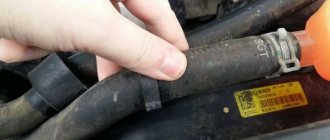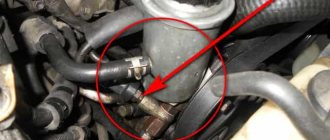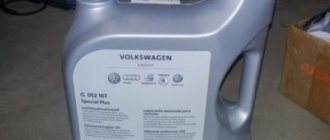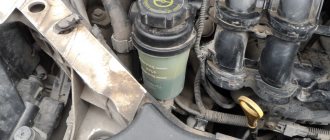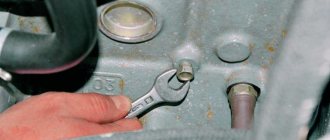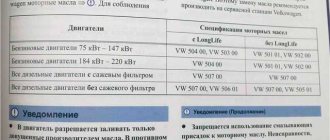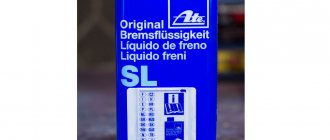When a car enthusiast smells something burning or determines that the steering wheel is harder to turn and the car doesn’t handle well on the road, then you need to start updating the oil.
Author of the article: Yaroslav Alchevsky 04/26/2020 0 0
Good operation of the power steering is the key to safe operation of the car on the road and making the driver’s task easier. Successfully changing the oil in the power steering Volkswagen Passat B5 will allow you to know about the oil manufacturer, the timing of the change, as well as the correct sequence of actions.
How to properly change the power steering fluid in an Audi A6?
Replacing the power steering fluid in the Audi A6 is necessary if at least one of the following symptoms is present:
- excessive noise when the pump is running;
- increased effort when turning the steering wheel;
- the steering wheel turns with uneven jerks;
- when checked, the oil turned out to be dark in color or changed consistency;
- low fluid level in the steering reservoir.
According to the regulations, the power steering lubricant in the Audi A6 should be changed every 30,000 km. If the driver drives intensively, these periods may be reduced.
First stage
The required volume is 1 liter.
G002 and G004 can be mixed with each other if it is not known which oil was originally poured.
List of tools for replacing power steering fluid on an Audi A6:
- two jacks;
- special syringe;
- set of screwdrivers and pliers;
- hole plug;
- bottle;
- extension cord with fitting;
- new oil.
Second phase
Before starting work, you should jack up the car so that the front wheels are hanging and they can rotate freely.
Draining the old fluid is carried out in the following order:
- Remove the protection from the power steering reservoir and disconnect the connector fastenings;
- Take a syringe and connect a tube or hose to it and lower it into the tank;
- Pump out the old slurry into a container;
- Lower the end of the tube into the suction pipe of the pump and pick up the old mixture;
- Loosen and move two clamps from the lower pipes and remove the tank;
- You can wash it with water or a special product;
- Move the suction pipe to the side, and lower the second one into the container;
- Sit behind the wheel and turn it in both directions to the limit so that the entire mass comes out of the rack;
- Connect the suction pipe to the tank and close the supply hole with a plug;
- Add oil and turn the steering wheel again to the limit. This is necessary so that the remnants of the old mass come out of the system channels;
- Perform manipulations until the liquid at the outlet is as clean as at the inlet;
- To clean the power steering pump, start the engine for a couple of seconds. It is important that at this moment all the mass does not leave the tank into the system. Remaining oil will come out again through the drain channel;
- Reassemble the system in reverse order.
Third stage
Now that all the old mixture has flowed out and the reservoir with its components has been cleaned, you can pour new oil into the power steering of your Audi:
- Pour new product into the tank opening up to the MAX level.
- Start the engine and turn the steering wheel.
- Add oil if necessary.
This completes the repair.
Passat B5/B5+ Replacement of power steering fluid (report with photos).
Good day to all Forum members! I present for your discussion a photo report on replacing the power steering fluid. Two years have passed since its previous replacement, and it was decided to replace it for preventive purposes. I needed two cans (2 liters) of the original liquid: So. 1. Put the car on the handbrake, the speed is in neutral and raise the front of the car on the right and left with jacks, because there is no lift.
[/URL][/IMG]
[/URL][/IMG]
2. Remove the crankcase protection.
[/URL][/IMG]
3. Raise the hood.
[/URL][/IMG]
4. Remove the plastic casing of the power steering reservoir by sliding the plastic “whiskers” from the bottom of the cover.
[/URL][/IMG]
[/URL][/IMG]
5. Pump out the liquid from the tank into a transparent container.
[/URL][/IMG]
6. Having pumped out the liquid, we see a filter at the bottom of the tank. It is from this side that we will remove the hose to pump the liquid, i.e. the outlet from the tank from which I removed the hose is located closer to the windshield
.[/URL][/IMG]
7. This is the color of the liquid pumped out of the tank. Its color and smell, unlike the new liquid, are far from ideal. The color can be compared to new liquid, and the smell is reminiscent of burnt chemicals. Considering that the fluid has worked for two years, we conclude that it is advisable to replace it after two years, as advised at the Forum. Although, as they write, there are no regulations for replacing it, everyone can think about it and draw the appropriate conclusion. In addition, after pumping out, at the bottom of the tank, next to the filter, there was a small amount of metallic silver dust. Conclusion….
[/URL][/IMG]
8. I used this tool to dismantle the factory clamps. If it is not available, you can use pliers with long beaks.
[/URL][/IMG]
9. Use a clamp remover to compress and remove the hose clamp and remove the hose from the tank spout.
[/URL][/IMG]
10. In order not to dirty the compartment and wires too much, pump out as much liquid as possible from the hose.
[/URL][/IMG]
11. For convenience, remove the air pipe from the intercooler to the DZ. To do this, remove the clamp near the DZ, lift the top bracket securing the pipe to the intercooler and remove the pipe. Don't forget to plug the holes in the throttle body and intercooler with a rag.
[/URL][/IMG]
12. In order to lower the hose down and not completely stain the compartment with the wires, we muffle the hose with any suitable device for the diameter.
Differences in power steering oil changes in other Audi models
Replacing the fluid in the power steering on an Audi A6 C5 is carried out identically to the instructions described above. For filling, it is better to use the Swag product - a worthy analogue of the original liquid.
Replacing the Audi A8 power steering fluid is not a mandatory procedure, as the manufacturer claims, since the original product should be enough for the entire life of the car. In practice, it is recommended to change the power steering fluid on the A8 every 60 thousand km or once every 2 years. The replacement process is simplified: there is no need to turn the steering wheel, just start the engine for 10-20 seconds and all the old liquid will pour out of the system. In addition, when washing the tank, you should also clean the filter.
For many, replacing power steering fluid in an Audi A4 is a difficult task. This is due to the fact that it is difficult to get to the reservoir pumps due to the vacuum brake booster. The main thing is to not allow air to get into the system when changing the power steering oil.
Fluids used in power steering can be divided according to several criteria:
- Color;
- Compound;
- Variety.
VW Passat/Passat B5, B5GP (operation, repair.) v.3
Saturn Onliner Watch Club Thread starter
| 17 years on the site user #2850 Let's discuss the (+) (-) of this car. Interested in the opinions of happy or unhappy owners Gasoline or diesel, sedan or station wagon, which volume is better, typical diseases, real price, resource, etc. and so on. DJamalus Senior Member |
| 9 years on the site user #352056 Of course, I didn’t really understand it, but I think you are a little confusing the concepts of “camber alignment” and “rolling alignment” of wheels. IMHO: In the concept of “wheel alignment” there is a change in certain angular parameters of the wheels, something like this I don’t know much about this either, but everywhere they write that after replacing the bushings, the alignment should at least be checked https://www.google.com/search?sitesearch=http%3A%2F%2Fpassat-b5.ru. ssat-b5.ru Probably because of this, the camber on the front was not adjusted for me - either the master did not know or did not do it because of hemorrhoids. If you find such masters who can do it, let me know (I have a camber of -1.00 and -0.43, so it’s already at the tolerance limit). So far, everyone has the same answer - only toe in front, we don’t do anything at the rear. GreySerg Senior Member |
| 16 years on the site user #10327 If you find such masters who can do it, let me know (I have a camber of -1.00 and -0.43, so it’s already at the tolerance limit). So far, everyone has the same answer - only toe in front, we don’t do anything at the rear. -1.00 and -0.43 are included in the tolerance and the difference between them is 17 minutes, which is also included in the tolerance, I wouldn’t worry, I’m already 12 minutes over the tolerance, that’s why I’m bothering. I called the dealers: at Atlant M they told the machine builders 450 thousand + 100 thousand for non-original protection = 550 thousand for sukharevo even more expensive, 555 thousand + 110 thousand for non-original protection = 665 thousand. Somehow a little expensive, I’ll look for something cheaper . 01alex , I have almost the same thing on the left, by 6 minutes only the left camber is greater, according to the tolerance from -1.00 to -0.10 and the difference between left and right is a maximum of 30 minutes. bel-gsm Onliner Auto Club |
| 14 years on the site user #50327 Oils and fluids for power steering. Classification, interchangeability, miscibility. Popularly, oils for the power steering system are distinguished by color. However, the real differences are not in color, but in the composition of the oils, their viscosity, the type of base, and additives. Oils of the same color can be completely different and not even mix. To say that if red oil is poured in, then another red oil can be added is completely wrong. Therefore, use the table at the end of the page. The three colors of oil are as follows: 1) Red. Dexron family (mineral and synthetic red oils cannot be mixed!). Dexrons come in several types, but they all belong to the ATF class, i.e. class of oils for automatic transmissions (and sometimes power steering) 2) Yellow. The yellow family of power steering oils is most often used in Mercedes. 3) Green. Green oils for power steering (mineral and synthetic green oils cannot be mixed!) are loved by the VAG concern, as well as Peugeot, Citroen and some others. Not suitable for automatic transmissions. Mineral water or synthetic? The long-standing debate about which is better - synthetic or mineral water for the power steering system is not appropriate. The fact is that there are a lot of rubber parts in the power steering like nowhere else. Synthetic oils have a worse effect on the life of rubber parts based on natural rubber (almost all types of rubber), due to their chemical aggressiveness. In order to fill synthetic oils into the power steering system, its rubber parts must be designed for synthetic oils and have a special composition. It will be useful: Skoda has revealed the design of the most powerful Kodiaq Attention: rare cars use synthetic oils for power steering! But synthetic oils are often used in automatic transmissions. Fill the power steering system only with mineral water, unless the instructions specifically indicate synthetic oil! In order not to harm the power steering system, you must follow the rules: 1) Yellow and red mineral oils can be mixed 2) Green oils cannot be mixed with either yellow or red. 3) Mineral and synthetic oils cannot be mixed. How do automatic transmission oils differ from power steering oils, and why can they be used in power steering? The table below shows the functions of hydraulic fluids (oils) for power steering (PSF) and automatic transmissions (ATF): https://i31.fastpic.ru/big/2011/1001/d5/b54302ed39d3b5a54273b6f702db19d5.png The Dexron family was originally developed for use as hydraulic oils in automatic transmissions. Therefore, sometimes these oils are called transmission oils, which creates confusion, since transmission oils used to mean thick oils of the GL-5, GL-4, TAD-17, TAP-15 brands for gearboxes and rear axles with hypoid gears. Hydraulic oils are much thinner than transmission oils. It's better to call them ATPs. ATF stands for Automatic Transmission Fluid (literally - Fluid for automatic transmissions - i.e. automatic transmissions) As can be seen from the table above, oils for power steering and oils for automatic transmissions differ only in the presence in the latter of additional additives intended for automatic transmission clutches. But there are no clutches in the power steering system. Therefore, the presence of these additives does not make anyone hot or cold. This made it possible to safely fill automatic transmission oils into the power steering system. The Japanese, for example, have long filled power steering with the same oils as automatic transmissions. However, European manufacturers have gone further. They said: you cannot fill the power steering of our cars with any liquids other than those we specify. And you only need to buy them from us! This is a simple method to bind the consumer to you. In fact, if you pour suitable, high-quality, but non-original oil into the power steering, this will in no way affect its service life and performance. For example, the same ZF pumps work on different cars with different oils approved by the manufacturers themselves, and work equally well. This means yellow oils (Mercedes) and green oils (VAG) are equally good for power steering. The only difference is “the color of the ink.” At the same time, practice has shown that they cannot be mixed. In some cases, when mixing green and yellow power steering oils, foam appears. Therefore, before using a liquid of a different color, you just need to flush the system! When mixing mineral Dexrons and yellow power steering oils, no side effects occur. Their additives do not conflict with each other, but simply acquire their concentration in the new mixture and continue to fulfill their role. To clarify the miscibility of different power steering fluids, we provide the table below. However, the data in it relates only to the use of oils in power steering, but not in automatic transmissions! First group. This group contains “conditionally miscible” oils. If there is an equal sign between them: , then this is the same oil, just from different manufacturers - they can be mixed in any way. And manufacturers do not intend to mix oils from adjacent lines. However, in practice, nothing terrible happens if two oils from adjacent rows are mixed. This will not in any way worsen the performance of the hydraulic booster and will not reduce its service life. Second group. This group contains oils that can only be mixed with each other. They cannot be mixed with any other oils from the tables above and below. However, they can be used instead of other oils, provided that the system is completely flushed of old oil. Third group. These oils can be used in power steering only if the specific type of oil is specified in the instructions for this vehicle. These oils can only be mixed with each other. They cannot be mixed with other oils. Just as you cannot fill them into the power steering system if this type of oil is not specified in the instructions. If in doubt, avoid using these oils. In the pictures, IMHO, everything is terribly mixed up... it should be G 002 000 - mineral water, G 004 000 - synthetic. and with Febi it seems to be the other way around (I don’t even want to figure it out, because you can’t pour it into the power steering, IMHO) If they are thinking of Febi, then only 6161. 6162 is not for VAG at all, but for BMW |
Color classification
It is wrong to be guided only by color gradation when choosing oil, although this practice is widespread among car owners. It is also often indicated what color liquids can be mixed and which ones should not be mixed.
Mixing is contraindicated with liquids based on composition and not color, and since now both mineral water and synthetics can be presented in any color, you should treat this information very carefully.
Red ATF gear oil is usually synthetic, the Dexron brand from General Motors is considered the standard, but there are products from other manufacturers, such as Revenol, Motul, Shell, Zic, etc.
Yellow oil, produced by the Daimler concern and under its license, is used in Mercedes-Benz hydraulic boosters. It can be synthetic and mineral.
Green oil. For the most part, multifunctional and universal liquids can be either synthetic or mineral in composition. They are used in power steering, suspension and other systems that operate on liquids. It cannot be mixed with other colors, except in cases where the manufacturer declares full compatibility, for example Comma PSF MVCHF is compatible with some types of Dexron.
What kind of oil to pour into the power steering system of Volkswagen Passat B5
When the car owner realized that it was time to change the operating oil in his Volkswagen, the next step towards the “health” of the car was to select the appropriate operating fluid. We remember that the quality of power steering oil is determined by the following parameters:
- liquid color;
- chemical composition;
- variety.
It is a bad idea to rely on only one of the parameters when choosing a product. A good liquid has a combination of qualities necessary for a particular car.
Oil for power steering system Volkswagen Passat B5
Characteristics of oils
The color of the oil is:
- Red (synthetic liquid).
- Yellow (synthetic and mineral liquid).
- Green (universal liquid).
Red oils are popular for use in Japanese-made cars. The yellow tint of the liquid is suitable for most European cars. Green oil is highly specialized; it is produced for certain car brands: Citroen and Peugeot.
Comparison of manufacturers and prices
The ideal oil for this car is the original power steering fluid - VAG G004000M2. Products from current market leaders: Shell, Dexron and Motul can serve as good analogues, but you should focus on the manufacturer’s recommendations.
Adding fluid to the power steering system
It often happens that during a routine inspection of the condition of the power steering fluid, the driver discovers an insufficient amount of oil. You need to add fluid to the max level to avoid further troubles on the road.
You need to add oil in small doses, but remember the mixing rules; it is advisable to pour the same brand of liquid as before.
Is it possible to mix oils?
In order not to spoil the power steering mechanisms, it is important to follow the mixing rules. These tips will be useful when updating your operating oil:
- If necessary, yellow and red mineral oils must be mixed.
- Oils with a green tint are not recommended to be mixed with others.
- Mineral and synthetic oils cannot be mixed.
Ignoring simple but important rules will result in dangerous damage to your vehicle, which can occur while driving at high speeds.
Liquid composition
Based on the composition of the power steering fluid, it can be divided into mineral, semi-synthetic and synthetic. The chemical composition determines the basic set of oil functions:
- Viscosity characteristics;
- Lubricating properties;
- Protection of parts from corrosion;
- Prevents foaming;
- Temperature and hydraulic properties.
Synthetics and mineral water cannot be mixed with each other, since the types of additives in them have fundamental differences.
Synthetics
These are high-tech liquids, in the production of which the most modern developments and additives are used. Oil fractions for synthetics are purified by hydrocracking. Polyesters, polyhydric alcohols and sets of additives give them outstanding characteristics: a wide range of operating temperatures, stable oil film, long service life.
The main reason why synthetic-based hydraulic fluid cannot be poured into power steering intended for mineral ones is its aggressive effect on rubber products, of which there are many in the hydraulic booster. Where synthetics are used, the rubber has a completely different composition and is made on a silicone basis.
Semi-synthetics
A mixture of synthetic and mineral oils, due to which the latter receive significant improvements in performance: reduced foaming, fluidity, heat dissipation.
Semi-synthetic fluids include such well-known fluids as: Zic ATF Dex 3, Comma PSF MVCHF, Motul Dexron III and others.
Mineralka
Mineral-based oils contain petroleum fractions (85-98%), the rest are additives that improve the performance of the hydraulic fluid.
They are used in hydraulic boosters containing seals and parts based on ordinary rubber, since the mineral component is neutral and is not harmful to rubber products, unlike synthetics.
Mineral power steering fluids are the most inexpensive, but they also have a short service life. Mobil ATF 320 Premium is considered a good mineral oil; Dexron oils up to and including the IID marking were also mineral.
Different types of oils
Dexron
- a separate class of ATF fluids from General Motors, produced since 1968. Dexron is a trademark, produced both by GM itself and by other companies under license.
ATF
(Automatic Transmission Fluid) - oils for automatic transmissions, often used by Japanese automakers and in power steering.
P.S.F.
(Power Steering Fluid) - literally translated as power steering fluid.
Multi HF
– special, universal power steering fluids that have approvals from most automobile manufacturers. For example, CHF liquid, produced by the German company Pentosin, has received approvals from BMW, Ford, Chrysler, GM, Porsche, Saab and Volvo, Dodge, Chrysler.
Is it possible to fill the power steering with engine oil?
Motor - definitely not, transmission - with reservations. Next we will look in detail why.
To understand whether other oils, such as motor or transmission oils, can be poured into the power steering, you need to know what functions it performs.
The power steering fluid must cope with the following tasks:
- Lubrication of all power steering components;
- Protection against corrosion and wear of parts;
- Pressure transfer;
- Prevents foaming;
- System cooling.
The above characteristics are achieved by adding various additives, the presence and combination of which gives power steering oil the necessary qualities.
As you understand, the tasks of motor oil are somewhat different, so it is highly not recommended to pour it into the power steering.
Regarding transmission oil, everything is not so clear; the Japanese often use the same ATF fluid for automatic transmission and power steering. Europeans insist on using special PSF (Power Steering Fluid) oils.
What kind of fluid to pour into the power steering
Based on this, the answer to the question “what kind of oil to pour into the power steering” is obvious - recommended by the manufacturer of your car. Often information is indicated on the expansion tank or cap. If there is no technical documentation, call an authorized center and ask.
In any case, experiments with steering are unacceptable. Not only your safety, but also that of those around you depends on the health of your power steering.
| car model | Recommended liquid |
| Audi 80, 100 (audi 80, 100) | VAG G 004 000 M2 |
| Audi A6 C5 (audi a6 c5) | Mannol 004000, Pentosin CHF 11S |
| Audi a4 (audi a4) | VAG G 004 000M2 |
| Audi a6 c6 (audi a6 c6) | VAG G 004 000M2 |
| BMW e34 (BMW e34) | CHF 11.S |
| BMW E39 (BMW E39) | ATF Dextron 3 |
| BMW E46 (BMW E46) | Dexron III, Mobil 320, LIQUI MOLY ATF 110 |
| BMW E60 (BMW E60) | Pentosin chf 11s |
| BMW x5 e53 (BMW x5 e53) | ATF BMW 81 22 9 400 272, Castrol Dex III, Pentosin CHF 11S |
| VAZ 2110 | |
| VAZ 2112 | Pentosin Hydraulic Fluid (CHF,11S-tl, VW52137) |
| Volvo s40 (volvo s40) | Volvo 30741424 |
| Volvo xc90 (volvo xc90) | VOLVO 30741424 |
| Gas (Valdai, Sobol, 31105, 3110, 66) | |
| Gazelle business | Mobil ATF 320, Castrol-3, Liqui moly ATF, DEXTRON III, CASTROL Transmax Dex III Multivehicle, ZIC ATF III, ZIC dexron 3 ATF, ELF matic 3 |
| Gazelle next | Shell Spirax S4 ATF HDX, Dexron III |
| Geely MK | |
| Geely Emgrand | ATF DEXRON III, Shell Spirax S4 ATF X, Shell Spirax S4 ATF HDX |
| Dodge Stratus | ATF+4, Mitsubishi DiaQueen PSF, Mobil ATF 320 |
| Daewoo Gentra | Dexron-IID |
| Daewoo matiz | Dexron II, Dexron III |
| Daewoo Nexia | Dexron II, Dexron III, Top Tec ATF 1200 |
| Zaz chance | LiquiMoly Top Tec ATF 1100, ATF Dexron III |
| Zil 130 | T22, T30, Dexron II |
| Zyl bull | AU (MG-22A), Dexron III |
| Kamaz 4308 | TU 38.1011282-89, Dexron III, Dexron II, GIPOL-RS |
| Kia Carens | Hyundai Ultra PSF-3 |
| Kia rio 3 (Kia rio 3) | PSF-3, PSF-4 |
| Kia Sorento | Hyundai Ultra PSF-III, PSF-4 |
| Kia Spectra | Hyundai Ultra PSF-III, PSF-4 |
| Kia Sportage | Hyundai Ultra PSF-III, PSF-4 |
| Kia Cerato | Hyundai Ultra PSF-III, PSF-4 |
| Chrysler PT Cruiser | Mopar ATF 4+ (5013457AA) |
| Chrysler Sebring | Mopar ATF+4 |
| Lada Largus | Mobil ATF 52475 |
| Lada Priora | Pentosin Hydraulik Fluid CHF 11S-TL VW52137, Mannol CHF |
| Land Rover Freelander 2 | LR003401 pas fluid |
| Lifan smiley (lifan smily) | Dexron III |
| Lifan solano | Dexron II, Dexron III |
| Lifan X60 (lifan x60) | Dexron III |
| Maz | BRAND R (Oil MG-22-V) |
| Mazda 3 | Mazda M-3 ATF, Dexron III |
| Mazda 6 (mazda 6 GG) | Mazda ATF MV, Dexron III |
| Mazda cx7 (Mazda cx7) | Motul Dexron III, Mobil ATF320, Idemitsu PSF |
| Man 9 (Man) | MAN 339Z1 |
| Mercedes w124 (mercedes w124) | Dexron III, Febi 08972 |
| Mercedes w164 (mercedes w164) | A000 989 88 03 |
| Mercedes w210 (mercedes w210) | A0009898803, Febi 08972, Fuchs Titan PSF |
| Mercedes w211 (mercedes w211) | A001 989 24 03 |
| Mercedes Actros | Pentosin CHF 11S |
| Mercedes atego (mercedes atego) | Dexron III, Top Tec ATF 1100, MV 236.3 |
| Mercedes ML (mercedes ml) | A00098988031, Dexron IID, MB 236.3, Motul Multi ATF |
| Mercedes sprinter | Dexron III |
| Mitsubishi Outlander | Dia Queen PSF, Mobil ATF 320 |
| Mitsubishi Galant | Mitsubishi Dia Queen PSF, Mobil ATF 320, Motul DEXRON III |
| Mitsubishi Lancer 9, 10 (Mitsubishi Lancer) | Dia Queen PSF, Mobil ATF 320, Dexron III |
| Mitsubishi Montero Sport | Dexron III |
| Mitsubishi Pajero | Dia Queen PSF, Mobil ATF 320 |
| Mitsubishi Pajero 4 | Dia Queen PSF, Mobil ATF 320 |
| Mitsubishi Pajero Sport | Dia Queen PSF, Mobil ATF 320 |
| Mtz 82 | in summer M10G2, M10V2, in winter M8G2, M8V2 |
| Nissan Avenir | Dexron II, Dexron III, Dex III, Castrol Transmax Dex III Multivehicle |
| Nissan ad | NISSAN KE909-99931 "PSF |
| Nissan Almera | Dexron III |
| Nissan Murano | KE909-99931 PSF |
| Nissan Primera | ATF320 Dextron III |
| Nissan Teana J31 (Nissan Teana J31) | Nissan PSF KLF50-00001, Dexron III, Dexron VI |
| Nissan Cefiro | Dexron II, Dexron III |
| Nissan Pathfinder | KE909-99931 PSF |
| Opel Antara | GM Dexron VI |
| Opel Astra H (opel astra H) EGR | OPEL PSF 19 40 715, SWAG 99906161, FEBI-06161 |
| Opel Astra J | Dexron VI, General Motors 93165414 |
| Opel Vectra A | Dexron VI |
| Opel Vectra B | GM 1940771, Dexron II, Dexron III |
| Opel Mokka | ATF DEXRON VI" Opel 19 40 184 |
| Peugeot 206 | Total Fluide AT42, Total Fluide LDS |
| Peugeot 306 | Total Fluide DA, Total Fluide LDS |
| Peugeot 307 | Total Fluid DA |
| Peugeot 308 | Total Fluid DA |
| Peugeot 406 | Total Fluide AT42, GM DEXRON-III |
| Peugeot 408 | Total FLUIDE AT42, PENTOSIN CHF11S, Total FLUIDE DA |
| Peugeot partner | Total Fluide AT42, Total Fluide DA |
| Ravon Gentra | Dexron 2D |
| Renault duster | ELF ELFMATIC G3, ELF RENAULTMATIC D3, Mobil ATF 32 |
| Renault Laguna | ELF RENAULT MATIC D2, Mobil ATF 220, Total FLUIDE DA |
| Renault Logan | Elf Renaultmatic D3, Elf Matic G3 |
| Renault Sandero | ELF RENAULTMATIC D3 |
| Renault simbol | ELF RENAULT MATIC D2 |
| Citroen Berlingo | TOTAL FLUIDE ATX, TOTAL FLUIDE LDS |
| Citroen C4 (Citroen C4) | Total Fluide DA, TOTAL FLUIDE LDS, Total Fluide AT42 |
| Scania | ATF Dexron II |
| SsangYong New Actyon | ATF Dexron II, Total Fluide DA, Shell LHM-S |
| SsangYong Kyron | Total Fluide DA, Shell LHM-S |
| Subaru Impreza | Dexron III |
| Subaru Forester | ATF DEXTRON IIE, III, PSF Fluid Subaru K0515-YA000 |
| Suzuki Grand Vitara | Mobil ATF 320, Pentosin CHF 11S, Suzuki ATF 3317 |
| Suzuki Liana | Dexron II, Dexron III, CASTROL ATF DEX II multivehicle, RYMCO, Liqui Moly Top Tec ATF 1100 |
| Tata (truck) | Dexron II, Dexron III |
| Toyota Avensis | 08886-01206 |
| Toyota Carina | Dexron II, Dexron III |
| Toyota Corolla (Toyota Hiace) | Dexron II, Dexron III |
| Toyota Land Cruiser Prado 120 (Toyota Land Cruiser 120) | 08886-01115, PSF NEW-W, Dexron III |
| Toyota Land Cruiser Prado 150 (Toyota Land Cruiser 150) | 08886-80506 |
| Toyota Land Cruiser Prado 200 (Toyota Land Cruiser 200) | PSF NEW-W |
| Toyota Hiace | Toyota ATF DEXTRON III |
| Toyota Chaser | Dexron III |
| UAZ loaf | Dexron II, Dexron III |
| UAZ patriot, hunter | Mobil ATF 220 |
| Fiat Albea | DEXRON III, ENEOS ATF-III, Tutela Gi/E |
| Fiat Doblo | Spirax S4 ATF HDX, Spirax S4 ATF X |
| Fiat Ducato | TUTELA GI/A ATF DEXRON 2 D LEV SAE10W |
| Volkswagen Vento | VW G002000, Dexron III |
| Volkswagen Golf 3 | G002000, Febi 6162 |
| Volkswagen Golf 4 | G002000, Febi 6162 |
| Volkswagen Passat B3 | G002000, VAG G004000M2, Febi 6162 |
| Volkswagen Passat B5 (Volkswagen passat B5) | VAG G004000M2 |
| Volkswagen Transporter T4, T5 (Volkswagen Transporter) | VAG G 004 000 M2 Power Steering Fluid G004, Febi 06161 |
| Volkswagen Touareg | VAG G 004 000 |
| Ford Mondeo 3 (ford mondeo 3) | FORD ESP-M2C-166-H |
| Ford Mondeo 4 | WSA-M2C195-A |
| Ford transit | WSA-M2C195-A |
| Ford Fiesta | Mercon V |
| Ford Focus 1 | Ford WSA-M2C195-A, Mercon LV Automatic, FORD C-ML5, Ravenol PSF, Castrol Transmax Dex III, Dexron III |
| Ford Focus 2 | WSS-M2C204-A2, WSA-M2C195-A |
| Ford Focus 3 | Ford WSA-M2C195-A, Ravenol Hydraulik PSF Fluid |
| Ford Fusion | Ford DP-PS, Mobil ATF 320, ATF Dexron III, Top Tec ATF 1100 |
| Hyundai Accent | RAVENOL PSF Power Steering Fluid, DEXRON III |
| Hyundai Getz | ATF SHC |
| Hyundai Matrix | PSF-4 |
| Hyundai SantaFe | Hyundai PSF-3, PSF-4 |
| Hyundai Solaris | PSF-3, Dexron III, Dexron VI |
| Hyundai Sonata | PSF-3 |
| Hyundai Tucson/Tucson | PSF-4 |
| Honda accord 7 | PSF-S |
| Honda Odyssey | Honda PSF, PSF-S |
| Honda HRV | Honda PSF-S |
| Chery amulet | BP Autran DX III |
| Chery bonus | Dexron III, DP-PS, Mobil ATF 220 |
| Chery very | Dexron II, Dexron III, Totachi ATF Multi-Vehicle |
| Chery indis | Dexron II, Dexron III |
| Chery Tiggo | Dexron III, Top Tec ATF 1200, ATF III HC |
| Chevrolet Aveo | DEXTRON III, Eneos ATF III |
| Chevrolet Captiva | Power Steering Fluid Cold Climate, Transmax Dex III Multivehicle, ATF Dex II Multivehicle |
| Chevrolet Cobalt | DEXRON VI |
| Chevrolet Cruze | Pentosin CHF202, CHF11S, CHF7.1, Dexron 6 GM |
| Chevrolet Lacetti | DEXRON III, DEXRON VI |
| Chevrolet Niva | Pentosin Hydraulic Fluid CHF11S VW52137 |
| Chevrolet Epica | GM Dexron 6 No.-1940184, Dexron III, Dexron VI |
| Skoda Octavia tour | VAG 00 4000 M2, Febi 06162 |
| Skoda Fabia | Power Steering Fluid G004 |
| The data in the table is collected from publicly available sources | |
How to top up
The process of topping up is simple - you need to unscrew the cap of the power steering expansion tank and add enough fluid so that it is between the MIN and MAX marks.
The main problem when adding power steering oil is its choice. It’s good if the replacement has not yet been made, and the system contains fluid from the manufacturer’s factory. In this case, it is enough to check the technical documentation, take the recommended oil and add to the required amount.
If you don’t know what’s in the system, we recommend replacing it right away, because in any case you’ll have to buy a canister of liquid to top up.
The working fluid (oil) in the power steering of an Audi A6 C5, like other consumables, becomes unusable over time. In today’s article we will look at the mileage after which it is necessary to change the oil in the power steering of an Audi A6, we will dwell on the choice of technical fluid and consider the process of changing the oil itself.
Oil for power steering system Volkswagen Passat B5
When a car enthusiast smells something burning or determines that the steering wheel is harder to turn and the car doesn’t handle well on the road, then you need to start updating the oil.
Good operation of the power steering is the key to safe operation of the car on the road and making the driver’s task easier. Successfully changing the oil in the power steering Volkswagen Passat B5 will allow you to know about the oil manufacturer, the timing of the change, as well as the correct sequence of actions.
Fluid selection and replacement intervals
Audi manufacturers claim that power steering oil in the C5 model is filled for the entire service life of the car, so replacement due to aging and loss of properties is not necessary, but this is not entirely true
It is necessary to change the oil only in case of technical work affecting the hydraulic power steering system. And in cases of loss of oil level, you just need to top it up. Of course, add fluid only recommended by the manufacturer.
By the way, I already wrote to you about that, so if anyone is interested, be sure to read this article.
What kind of oil to fill in the power steering in a Volkswagen Passat B5
When it’s cold, the steering wheel turns easily, as soon as you drive it it’s tight, you can’t say that you can’t turn it, but it’s not right. The oil smells like wood, will replacing the fluid or the pump help??
Slavik (Musa) Andrey, try it... who knows how critical everything is there... (and it generally helps)
Andrey (Yedidia) Slavik, what is better to pour in, I have Phoebe mineral water in there, on the forums they write that type ATP 3 helps, will it suit me?
Slavik (Musa) Andrey, green oil is pouring in there..what ATF!! (and then as you know)..fill in the same... (do you know how to change??)
Andrey (Yedidia) Slavik, they write that it’s thick and it will be normal, well, I have green in it, and then I’ll pour green. Well, I read the current how, but no, what do you recommend how
Step-by-step instructions for changing the oil in the power steering of an Audi A6 with your own hands + photo report
- We open the hood, take the necessary tool: pliers (for removing clamps), a 10-mm wrench (for dismantling the power steering reservoir), a syringe with a tube (for pumping out fluid, so that there is less litter in the yard), a reservoir for old fluid (I used a plastic bottle) , a couple of jacks or hemp (to bleed the system you need to hang the front wheels) and that’s basically it.
- We remove the protective cover from the power steering reservoir, remove the connectors from the mount that will interfere and move them to the side.
- Next, take a pre-prepared syringe with a hose
- Lower the end of the hose into the power steering reservoir
- We begin pumping out (in reality, the color is “childish surprise”)
- And pour into the prepared container
- The syringe hose can be inserted even deep into the suction pipe of the pump and pump out the liquid to the maximum
- We remove the power steering reservoir, to do this we need to unclench and move down the two clamps on the lower pipes
- We wash the barrels for power steering fluid
- Now let's jack up the front wheels so they can turn smoothly.
- After disconnecting the pipes, we move the suction pipe (the thicker one on the pump) to the side so that it does not interfere and place it vertically. But we lower the thinner one (it comes from the cooling coil) into our container and continue to expel the liquid from the system. To do this, you yourself or an assistant (better, of course), sit behind the wheel and begin to turn the steering wheel left and right until the end ten times... At the same time, we hear how the liquid is expelled from the rack body. Since I did this whole process myself and without an assistant, running around with dirty hands and getting behind the wheel became somehow not comme il faut for me. At first I turned the steering wheel - it sucked, and then I started doing the following. In this process, our wheels are in a suspended position and turning the wheel (BY THE WHEEL ITSELF) is not a problem, so I took the disk (wheel) with my hands and, with sharp turns back and forth, pumped out as much of the old fluid as possible!
- In order to expel (drain) the liquid to the maximum, especially when you observe a terrible color picture, it was decided that the new liquid would squeeze out the remaining “poop”.
- So we take our washed tank, plug (I have a plastic bolt of the appropriate size) the supply channel (the thinner one), connect the suction pipe to the tank and fill in new liquid
- Using the manipulations described in paragraph “7”, we expel the remnants of gUaNo. To control the quality, so to speak, we take another bottle and “jerk off fate” (sorry for the bad French) until the color of the liquid, at least somewhere in the depths, seems green! That is, the color of the new liquid!
- When the color of the leakage suits us, we begin assembly in the reverse order of removal and disassembly
- Fill the reservoir with new fluid to the MAX level! And we ride for about ten kilometers (I did it even for a week and from 100 kilometers), periodically checking the fluid level in the tank and the absence of any leaks.


